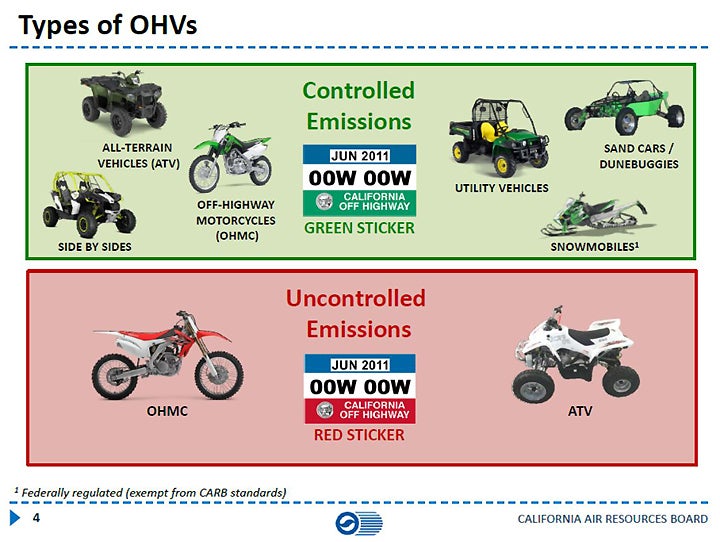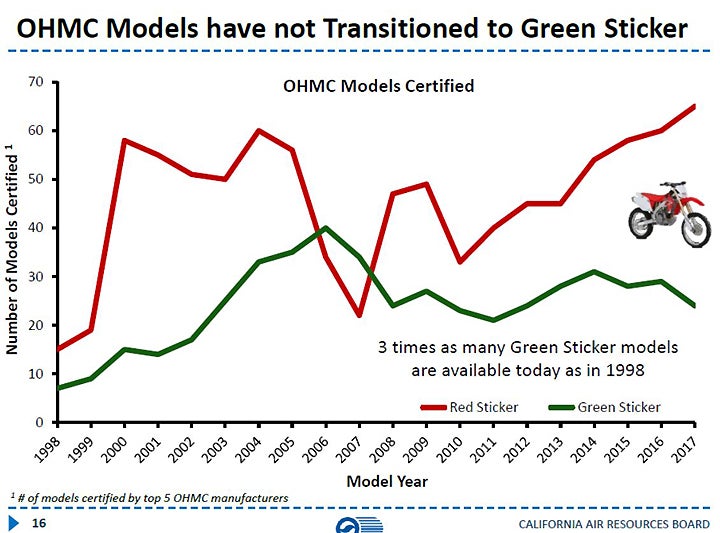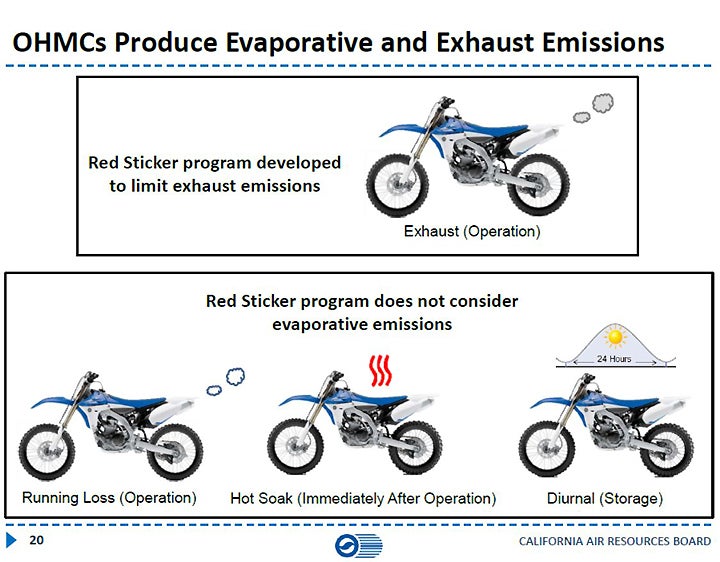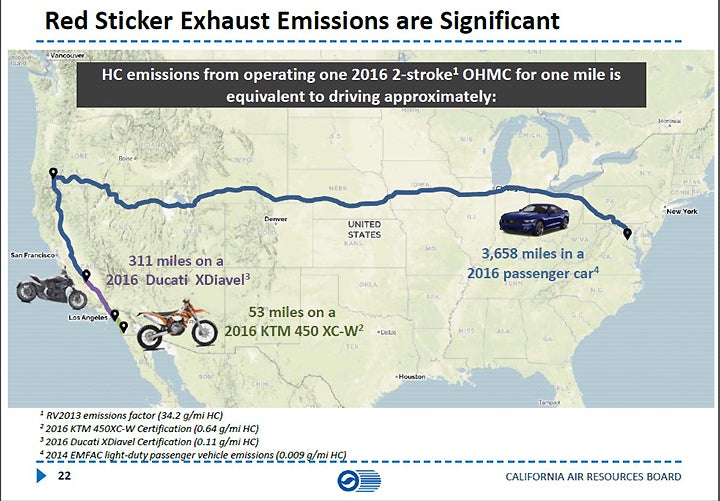If you ride an uncontrolled emissions (Red Sticker) off-road motorcycle in California, it looks like the shit is about to hit the fan.

You already know just how stringent the Golden State is when it comes to fighting air pollution, especially if said pollution is from vehicle emissions. It now appears that the next chapter in California’s battle against the gods of internal combustion will involve the OHV community. Brace yourself, because you may soon find that your Red Sticker off-road vehicle can no longer be legally operated on public lands in California.
According to a report published by the California Environmental Protection Agency’s Air Resources Board (or ARB, formerly known as CARB), Red Sticker vehicles—those vehicles that have long held an emissions exempt status so that they could be operated seasonally (typically between April through October, depending on the OHV park) on public land have been identified by ARB as gross polluters, and they are now being targeted for changes that could cause existing models to be “phased out” of the Red Sticker program before the Red Sticker program is itself regulated out of existence completely.
Before we get into the details, let’s back-track for a moment and recall how we got here in the first place: Back in 1994, CARB adopted its first set of emissions standards governing OHVs, and it established a program whereby OHVs that met those standards were certified for use on public land through the Green Sticker program, an off-road vehicle registration that already existed as a means of generating revenue for the maintenance of state OHV areas.
But then in 1996 CARB made another announcement that any off-road motorcycle manufactured after January 1, 1997 that failed to meet the newly announced emission guidelines set by CARB in order to qualify for a Green Sticker would not be able to be registered for public land use. That meant that any off-road machine built later than that was deemed illegal to ride on public land. In much the same fashion that 1975 and older automobiles do not require smog checks to receive license plate tags, pre 1998 off-road motorcycle models remained exempt from the emission requirements, and they can still obtain an unlimited use Green Sticker.

However, in the face of mounting pressure from OHV advocate groups, some of whom claimed CARB had used faulty data and inflated numbers to back those new regulations, CARB changed its stance in December 1998 and approved the initiation of the seasonal use “Red Sticker” program for vehicles that could not meet Green Sticker emissions standards. Faulty data or not, the reality was that the Red Sticker alternative probably prevented the motorcycle industry from taking a serious nosedive at a time when the OEMs offered very few off-road models that could meet Green Sticker emissions standards. The Red Sticker program was a reprieve for motorcyclists who wanted to ride their 1998 or later two- or four-stroke motocross or off-road bikes on public trails and OHV parks, so long as the their bikes were fitted with spark arrestors.
And that’s how we have rolled since 1998… until now, where CARB’s latest “workshop” report has just revealed what it deems to be serious and correctable flaws in the current Red Sticker program. ARB proposed a new regulation to control OHV evaporative emissions in 2013 by requiring tight control of reactive organic gas (ROG), which could allegedly result in a reduction of 9.9 tons of ROG by 2035. As a part of that process, ARB also directed its staff to return with additional recommendations for curbing Red Sticker OHV emissions by 2015. When the ARB staff returned with its findings, the situation didn’t look so promising for the existing Red Sticker program.

By using a combination of emissions testing of Red Sticker two-stroke and four-stroke OHVs, an evaluation of the location and population of Red Sticker OHVs in the state, and nearly 3000 owner survey responses, it was determined that of the total pool of just over one million OHVs in the state of California, which includes 494,138 ATVs and 478,102 off-road motorcycles, ATVs have largely transitioned to emissions-compliant Green Sticker models while off-road motorcycles have not. According to the study, Red Sticker off-road motorcycles actually exceed the population of Green Sticker off-road motorcycles by a proportion of 53.6 percent Red Sticker to 46.4 percent Green Sticker.
The data showed that Red Sticker OHVs did not comply with regulations for tail pipe emissions when compared to Green Sticker OHVs—not much of a shocker there—but the study also revealed that there were issues with the Red Sticker regulations themselves since they did not account for other measurable emissions from Red Sticker vehicles besides those that come from the tail pipe during normal operation. These include:
-Running loss–evaporative HC emissions that occur when hot fuel vapors escape from the fuel system or overwhelm the carbon canister while the vehicle is operating
-Hot soak–fuel vapors emitted from a vehicle after the engine is turned off.
-Diurnal emissions–evaporated gasoline emissions generated by the rise in temperature over the course of a day when the vehicle is not being driven, such as when it is being stored.

Based on the gathered emissions data, the study claimed that the emissions output of a typical two-stroke off-road motorcycle ridden just one mile was equal to that of a KTM 450 XC-W four-stroke ridden 53 miles, or an 1198cc Ducati Diavel streetbike ridden 311 miles, or the average passenger car driven 3615 miles!
Now, if you’re familiar with this whole issue, you might be thinking, “Wait a second, the reason the Red Sticker program exists is to allow competition vehicles to be ridden, tested and practiced on pubic lands,” and you’d be correct. However, the owner survey showed that 90 percent of Red Sticker off-road motorcycles in California are primarily used for recreation. Fully 74 percent of the respondents confirmed that they never compete, and the survey showed that competition only accounts for six percent of Red Sticker OHV operation. As ARB sees it, the Red Sticker program is merely a loophole that allows OHVs to skirt emissions standards that are much lower for on-road motorcycles and Green Sticker OHVs. The study also concluded that the Red Sticker program provides no incentive for zero-emission technology.
Citing California’s goal of significant emission reductions to meet critical air quality and climate goals, the study concluded that additional reductions are needed from multiple sources, including OHVs. In other words, a big change is coming.
The ARB proposal features two parts, including a sunset of the Red Sticker program, which means establishing a set date at which the program will cease to exist, while also establishing a date to end the summer riding restrictions of the current program. That won’t really matter much if the program is terminated because owners of currently emissions-exempt off-road motorcycles and ATVs will no longer be allowed to operate their vehicles on public land in California anyway.

The second part of the proposal calls for a significant tightening of emissions standards on all OHVs and an incentive for zero-emissions OHV development. The study also contains language that suggests there will be some sort of provision in the pending regulations to protect true competition OHVs for use on public land—presumably meaning that you’ll still be able to race your emissions-exempt off-road motorcycle or ATV on public land, but you won’t be able to practice or test it there.
So, is the ARB proposal a disaster in the making or a catalyst for some needed change? That’s honestly a good question. Consider KTM’s recent announcement of its new2 018 KTM 250 XC-W TPI, which introduces viable production EFI on a two-stroke motorcycle, a system that not only significantly increases fuel economy, but also decreases emissions. There’s no reason to suggest that the motorcycle industry can’t produce high-performance vehicles that are capable of meeting newer emissions standards, something that the automobile industry has proven time and time again. That’s how the average consumer can walk into a car dealership and purchase a 2017 Corvette Z06 that produces 650 horsepower and 650 lb.-ft of torque and is capable of high 10-second quarter mile times and 200 mph top speeds, all while still meeting today’s ultra-strict EPA emissions standards.
The bigger question, of course, will be what incorporating such technology will do to the MSRP of a given off-road model. After all, that ‘Vette can be purchased, but it will still set you back about $80K for a no-options base trim level. Could we see an era where ARB-compliant off-road motorcycles suddenly cost $15-20K? It’s possible, but like everything, the adapting new technology always costs a lot in the beginning but tends to decrease over time—think computers and smart phones.

Of course in the four-stroke realm the change is already taking place. We now have several credible competition level off-road bikes like KTM EXCs, Betas, Huskys and models from other small-volume brands that aren’t just Green Sticker legal, they are actually street legal with license plates, lights and all! If we look at this honestly, it isn’t exactly doom and gloom, especially if new EFI two-strokes can eventually attain Green Sticker status
According to the ARB study, there’s more discussion to come, but it appears to be on a set schedule. A competition workshop has been set for June, 2017 with an on-road motorcycle and OHV emission standard kick-off workshop is scheduled for later this summer. A regulatory proposal workshop is expected to take place in October, 2017 followed by a Red Sticker Board hearing in February of 2018.
No matter the outcome of those meetings, like it or not, our off-road lifestyle is headed for a change.
 Your Privacy Choices
Your Privacy Choices